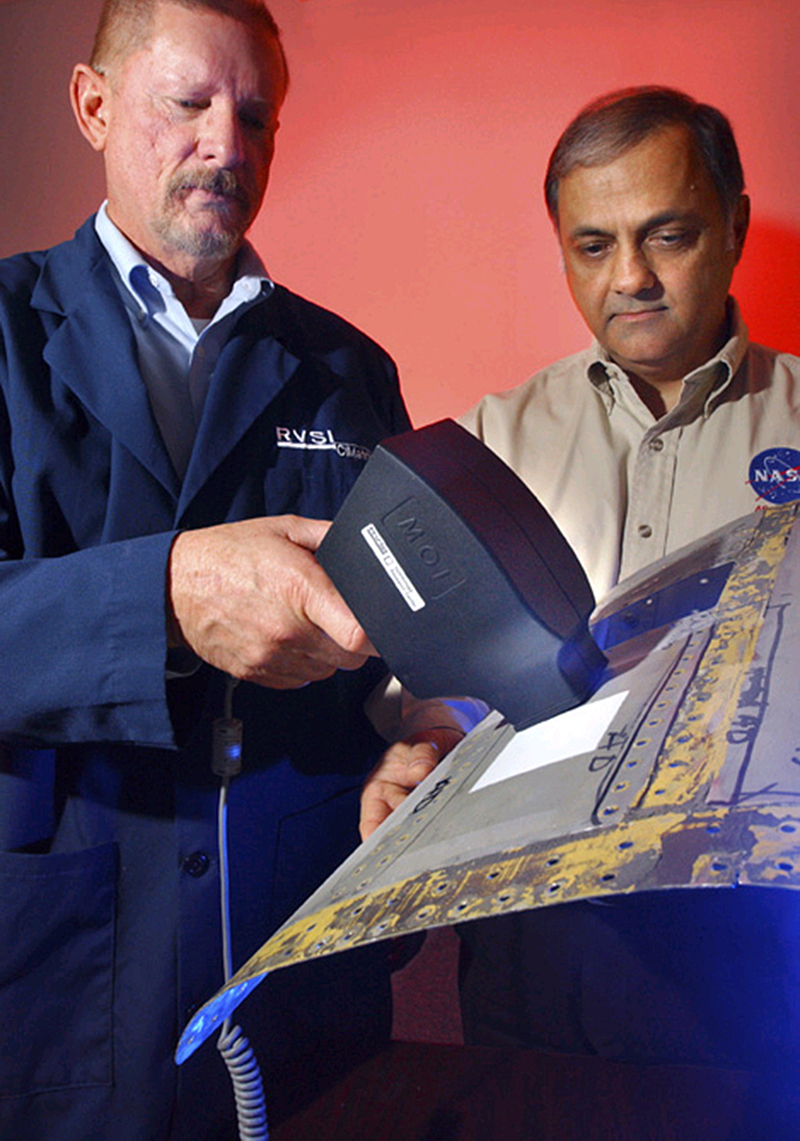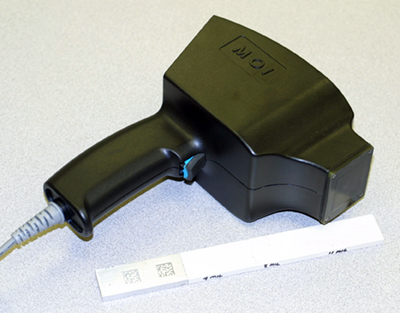
Reading Through Paint
Originating Technology/ NASA Contribution
Two-dimensional data matrix symbols, which contain encoded letters and numbers, are permanently etched on items for identification. They can store up to 100 times more information than traditional bar codes. While the symbols provide several advantages over bar codes, once they are covered by paint they can no longer be read by optical scanners. Since most products are painted eventually, this presents a problem for industries relying on the symbols for identification and tracking.
In 1987, NASA’s Marshall Space Flight Center began studying direct parts marking with matrix symbols in order to track millions of Space Shuttle parts. Advances in the technology proved that by incorporating magnetic properties into the paints, inks, and pastes used to apply the matrix symbols, the codes could be read by a magnetic scanner even after being covered with paint or other coatings. NASA received a patent for such a scanner in 1998, but the system it used for development was not portable and was too costly. A prototype was needed as a lead-in to a production model.
In the summer of 2000, NASA began seeking companies to build a hand-held scanner that would detect the “Read Through Paint” data matrix identification marks containing magnetic materials through coatings. Through the Research Triangle Institute’s efforts to connect NASA to small, high-technology businesses, the Agency was introduced to PRI Research & Development Corporation (PRI), of Torrance, California. PRI possessed a fully mature and successfully operating inspection system, known as the Magneto-Optic Imager (MOI), which enabled aviation technicians to inspect commercial and military aircraft for cracks and corrosion beneath paint and other surface coatings. Although the MOI could not be used in its current configuration for the application intended by NASA, PRI provided expertise and a system at the highest technology readiness level from which to start. NASA Marshall’s 13 years of direct part marking experience had enabled it to determine the reading requirements for identification symbols marked directly on parts through coatings. As a result, Marshall could provide PRI with a well-defined application, an understanding of what needed to be developed, and first-hand expertise.
Partnership
After meeting with Marshall, PRI accepted the challenge to build a hand-held MOI specifically for detecting data matrix symbols through paint. NASA and PRI signed a Space Act Agreement in September 2000, stating they would work together on the MOI, sharing the cost as well as any intellectual property that resulted. NASA purchased the parts and components for the prototypes, while PRI provided the design, engineering, and assembly services. Sharing the costs greatly reduced the risk to PRI as a small business, and enabled NASA to participate in the development process of a product that would best suit its application.
PRI’s Dr. William Shih, Gerald Fitzpatrick, and Craig Knisely worked with Marshall engineers to adapt PRI’s MOI technology to its new application. They removed unneeded functionality of PRI’s existing product to focus the device on its scanning mission, driving down both the size and cost of the magnetic scanner. The team also incorporated components from the HE-30 optical scanning product manufactured by Robotic Vision Systems, Inc. (RVSI), of Nashua, New Hampshire.
Product Outcome
As a result of the Space Act Agreement and the work completed by NASA and PRI, another patent application was filed for the improved version of the MOI. The hand-held MOI is now the approximate size and weight of a portable hair dryer. In addition to detecting codes covered by paint, primers, and laminates, the scanner reads marks obscured by discoloration or contamination. While PRI manufactures the hand-held scanner, RVSI was granted a license to market the new product. Introduced for sale as the “RVSI Magneto-Optic Imager,” model number A1-80299-1, the MOI enhances the company’s already impressive optical reader and vision system product line with the first scanner capable of reading data matrix symbols covered with paint.
RVSI successfully tested the first MOI prototype for the National Center for Manufacturing Sciences/Department of Defense (DoD) Retrofit Part Marking Development Program to demonstrate that both optical and Read Through Paint markings can survive and remain readable in operations, maintenance, repair, and overhaul environments. Magnetic marks placed on aircraft operated by the U.S. Coast Guard survived after 8 months of flight, and the MOI successfully imaged the data matrix symbols through the several layers of paint on the aircraft. This Phase II cooperative effort between NASA, the Coast Guard, RVSI, the DoD, and others is setting the stage for a Phase III effort to push the limits on Read Through Paint methods.
A variety of commercial applications are being explored by those involved in automatic identification. The MOI has the potential to help businesses improve inventory management, enhance safety, improve security, and aid in recall efforts. With more products in the world painted than not, the market for the MOI is very promising, particularly in the airline, automotive, electronics, and health care industries. For example, the automotive industry needs a flat identification mark under the paint that does not detract from a high-gloss paint job. The electronics industry, pharmaceutical industry, and others are becoming aware that product identification is no longer limited to marks that can be seen. Eventually, customers may receive packages with a visible mark on the top label and a magnetic mark underneath, or no visible marks on the outside at all, depending on the need for security.
The MOI demonstrates the spin-in aspect of the technology transfer process. Through PRI and NASA’s partnership, a new capability was created to help NASA track painted parts. With the MOI being spun-off, a product was created for the commercial market, enabling the technology to solve similar problems for the DoD, the automotive industry, and other market sectors. In addition to solving a serious tracking problem, the collaboration has added a new product to PRI’s production line and a new product to RVSI’s sales portfolio.

The Magneto-Optic Imager reads and decodes magnetic matrix symbols that are obscured by paint or other coatings.

Robotic Vision Systems, Inc., successfully demonstrated the magnetic hand-held scanner’s ability to help NASA track painted Space Shuttle parts.













